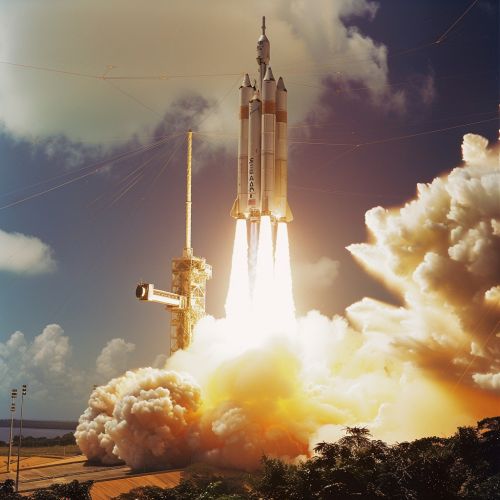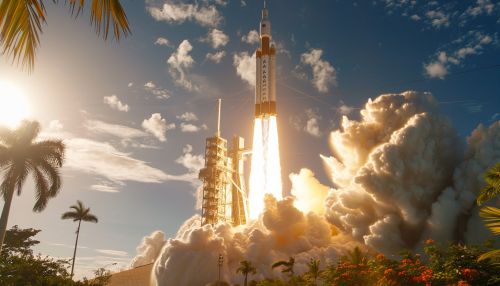Ariane 4: Difference between revisions
(Created page with "== Introduction == The Ariane 4 was a European expendable launch system developed and operated by Arianespace. It was the fourth iteration of the Ariane rocket family, which has been instrumental in establishing Europe's presence in the space launch market. The Ariane 4 was renowned for its versatility, reliability, and cost-effectiveness, making it a workhorse for commercial satellite launches from its introduction in 1988 until its retirement in 2003. == Development...") |
No edit summary |
||
| (One intermediate revision by the same user not shown) | |||
| Line 15: | Line 15: | ||
* **Third Stage:** The third stage, known as the H10 stage, was powered by a single HM7B engine. This stage was responsible for the final insertion of the payload into its designated orbit. | * **Third Stage:** The third stage, known as the H10 stage, was powered by a single HM7B engine. This stage was responsible for the final insertion of the payload into its designated orbit. | ||
[[Image:Detail-79211.jpg|thumb|center|Ariane 4 rocket launching from the Guiana Space Centre.|class=only_on_mobile]] | |||
[[Image:Detail-79212.jpg|thumb|center|Ariane 4 rocket launching from the Guiana Space Centre.|class=only_on_desktop]] | |||
=== Payload Capacity === | === Payload Capacity === | ||
Latest revision as of 15:02, 17 May 2024
Introduction
The Ariane 4 was a European expendable launch system developed and operated by Arianespace. It was the fourth iteration of the Ariane rocket family, which has been instrumental in establishing Europe's presence in the space launch market. The Ariane 4 was renowned for its versatility, reliability, and cost-effectiveness, making it a workhorse for commercial satellite launches from its introduction in 1988 until its retirement in 2003.
Development and Design
The development of the Ariane 4 began in the early 1980s, driven by the need for a more powerful and flexible launch vehicle to meet the growing demands of the commercial satellite market. The European Space Agency (ESA) and the French space agency CNES were the primary organizations behind its development. The design of the Ariane 4 was an evolution of its predecessor, the Ariane 3, incorporating several significant improvements and innovations.
Structural Design
The Ariane 4 featured a modular design that allowed for different configurations to accommodate various payload requirements. The core vehicle consisted of three stages:
- **First Stage:** The first stage was powered by four Viking 5C engines, which provided the necessary thrust for lift-off. The stage was equipped with four liquid-fueled strap-on boosters (either solid or liquid) to enhance its performance.
- **Second Stage:** The second stage utilized a single Viking 4B engine, which was an upgraded version of the Viking 4 engine used in the Ariane 3. This stage provided the necessary thrust to propel the payload into a higher altitude.
- **Third Stage:** The third stage, known as the H10 stage, was powered by a single HM7B engine. This stage was responsible for the final insertion of the payload into its designated orbit.


Payload Capacity
The Ariane 4 was designed to be highly adaptable, with the ability to launch a wide range of payloads, including geostationary satellites, low Earth orbit satellites, and scientific missions. Depending on the configuration, the Ariane 4 could carry payloads ranging from 2,000 to 4,800 kilograms to geostationary transfer orbit (GTO).
Launch Configurations
The Ariane 4 was available in six different configurations, designated by the number of strap-on boosters and their type:
- **Ariane 40:** No strap-on boosters.
- **Ariane 42P:** Two solid rocket boosters (PAP).
- **Ariane 44P:** Four solid rocket boosters (PAP).
- **Ariane 42L:** Two liquid rocket boosters (PAL).
- **Ariane 44L:** Four liquid rocket boosters (PAL).
- **Ariane 44LP:** Two solid and two liquid rocket boosters.
This modular approach allowed Arianespace to tailor each launch to the specific needs of the payload, optimizing performance and cost-efficiency.
Operational History
The Ariane 4 made its maiden flight on June 15, 1988, successfully placing three satellites into orbit. Over its operational lifetime, the Ariane 4 conducted 116 launches, with a remarkable success rate of over 97%. This high reliability earned it a reputation as one of the most dependable launch vehicles of its time.
Notable Missions
Several notable missions were conducted using the Ariane 4, including the launch of the TOPEX/Poseidon oceanography satellite, the deployment of the Intelsat VII series of communications satellites, and the launch of the Cluster mission for ESA, which studied the Earth's magnetosphere.
Retirement
The Ariane 4 was retired in 2003, following the successful introduction of its successor, the Ariane 5. The final flight of the Ariane 4 took place on February 15, 2003, marking the end of an era for one of the most successful launch vehicles in history.
Legacy
The Ariane 4's legacy is marked by its significant contributions to the commercial satellite launch market and its role in establishing Arianespace as a leading provider of launch services. The lessons learned from the development and operation of the Ariane 4 have been instrumental in the design and success of subsequent launch vehicles, including the Ariane 5 and the upcoming Ariane 6.
See Also
- Ariane 1
- Ariane 2
- Ariane 3
- Ariane 5
- European Space Agency
- Geostationary Transfer Orbit
- Satellite Launch Vehicle
